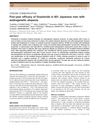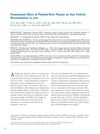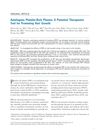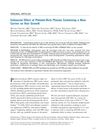TLDR PRP injections effectively improve hair growth in androgenic alopecia.
The study evaluated the effectiveness of platelet-rich plasma (PRP) injections in treating androgenic alopecia in 18 patients, consisting of 7 women and 9 men. Patients received three PRP injections at 21-day intervals, and results were assessed through clinical photographs, dermoscopy, and questionnaires. Women reported an average improvement of 42.85%, while external observers noted a 35.71% improvement. Men reported a 25.55% improvement, with observers noting an 18.88% improvement. Dermoscopy showed hair thickening, improved circulation, and increased follicle numbers. The study concluded that PRP injections provided an effective and satisfactory response in treating androgenic alopecia.
 13 citations
,
April 2015 in “Journal of Dermatology”
13 citations
,
April 2015 in “Journal of Dermatology” Finasteride effectively promotes hair growth and reduces hair loss in men with androgenetic alopecia.
 63 citations
,
October 2013 in “Dermatologic Surgery”
63 citations
,
October 2013 in “Dermatologic Surgery” Platelet-Rich Plasma (PRP) increases the number of new hair follicles and speeds up hair formation.
 270 citations
,
March 2012 in “Dermatologic Surgery”
270 citations
,
March 2012 in “Dermatologic Surgery” Platelet-rich plasma can potentially promote hair growth by stimulating cell growth and increasing certain proteins.
 166 citations
,
August 2011 in “Dermatologic Surgery”
166 citations
,
August 2011 in “Dermatologic Surgery” Platelet-rich plasma with a new carrier significantly increases hair thickness without serious side effects.
56 citations
,
December 1990 in “Differentiation” Growth factors can either promote or inhibit hair follicle cell growth and collagen breakdown.
January 2015 in “Surgical and Cosmetic Dermatology” PRP injections effectively improve hair growth in androgenic alopecia.
 19 citations
,
January 2012 in “Dermato-endocrinology”
19 citations
,
January 2012 in “Dermato-endocrinology” Moderately high prolactin levels do not cause hair loss in women.
11 citations
,
March 1991 in “PubMed” Hormonal imbalances, including high prolactin and thyroid issues, contribute to hair growth problems in women.




